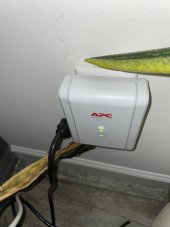Hello Forum, I have a very odd issue. With a multimeter with one lead on positive or negative the other lead on ground(earth) I show voltage. The voltage varies depending on solar irradiance (in excess of 160v +).
I have also used a oscilloscope to see the wave form and it has a very odd wave form. This happens at the PV Array as well as the inverters inputs (pictures attached). If I disconnect (via breaker and or pv disconnect)the PV array I don't get the voltage to ground (earth). Not sure if this is a normal occurrence with PV systems but, I do know ground conductors are not supposed to have potential on it. I will add that very little current (mA) if any.
Some input would be greatly appreciated.
@Will Prowse



I have also used a oscilloscope to see the wave form and it has a very odd wave form. This happens at the PV Array as well as the inverters inputs (pictures attached). If I disconnect (via breaker and or pv disconnect)the PV array I don't get the voltage to ground (earth). Not sure if this is a normal occurrence with PV systems but, I do know ground conductors are not supposed to have potential on it. I will add that very little current (mA) if any.
Some input would be greatly appreciated.
@Will Prowse



Last edited:




